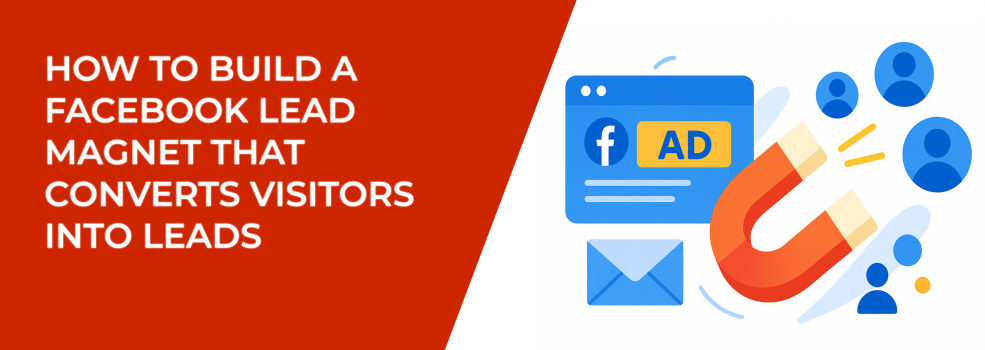Facebook advertising often feels like a numbers game, but throwing budget at a campaign doesn’t guarantee meaningful results. While reach and impressions might look impressive, they don’t translate into business outcomes unless you’re capturing actual interest, and that starts with a lead magnet that earns attention for the right reasons.
If your offer doesn’t resonate or feels like a dead end, even the most finely tuned targeting won’t save it. A truly effective Facebook lead magnet does more than collect email addresses. It creates a moment of value exchange, one that feels relevant and intentional. That’s what turns casual browsers into leads who are ready to hear more.
But how do you build something that cuts through the noise and actually converts?
Start with the person, not the product
The biggest misstep advertisers make is focusing on what they want to promote rather than what their audience is trying to achieve. Most people scrolling through social platforms aren’t in a buying mindset. They're trying to solve small, nagging problems, and they respond to businesses that understand those challenges better than the ones that rush to sell.
The most compelling lead magnets feel like an answer to a question someone hasn’t even fully articulated yet but knows they need help with.'
Here’s how to pinpoint what matters to your audience:
-
Join niche Facebook Groups your audience is active in and pay attention to repeated frustrations or requests.
-
Review comments on competitor ads to see which pain points are triggering conversation or emotion.
-
Talk to current or recent customers and ask what they were struggling with before they found your product or service.
-
Browse Reddit threads in your industry to spot common bottlenecks or misinformation.
-
Avoid overgeneralizing — "small business owners" is too broad. Define your niche based on industry, stage, or struggle.
Once you identify those specific struggles, the format and messaging of your lead magnet will come into focus naturally.
To dig deeper into building more refined customer personas, follow this step-by-step guide to defining a target audience for marketing.
Choose the right format based on Facebook behavior
Even a strong offer falls flat if it’s presented in a way that doesn’t suit the way people consume content on Facebook. These platforms aren’t built for long-form, multi-step experiences. They’re designed for speed, visual clarity, and short attention spans.
You need a format that respects the mindset of a casual scroller while offering enough depth to establish value quickly.
Some of the most effective lead magnet formats for Facebook include:
-
One-page checklists with a clear step-by-step framework or process.
-
Swipe files or templates that people can easily adapt and apply.
-
Mini-quizzes that feel interactive but capture contact info in the process.
-
Short PDF guides with direct, immediately actionable advice.
-
Interactive calculators that help users see potential outcomes or costs.
Whichever format you choose, it should be scannable, mobile-optimized, and visually simple. If someone can’t understand the benefit in under five seconds, the format is likely too complex.
Match the magnet to the funnel stage
A mismatch between lead magnet and funnel stage is one of the most common — and expensive — mistakes advertisers make. It’s not just about offering value; it’s about offering the right kind of value at the right time.
Someone who’s just been introduced to your brand needs something light and easy to digest. Someone further along the journey may be ready for a more involved tool that supports decision-making.
Here’s how to align lead magnet types with funnel stage:
-
Top of Funnel (cold audiences): templates, swipe files, or “starter” guides that help solve basic, annoying problems.
-
Middle of Funnel (engaged audiences): case studies, curated toolkits, or niche how-tos that showcase deeper expertise.
-
Bottom of Funnel (ready-to-buy leads): ROI calculators, detailed comparison sheets, or live strategy call invitations.
As your audience moves through your ecosystem, your offers should evolve with them not just in depth, but in tone and call to action. For a broader view of how to move users from cold awareness to conversion, explore this detailed Facebook Ads funnel strategy.
Pair it with a scroll-stopping ad
Even the best resource goes unnoticed if the ad doesn’t earn the click. You only have a second or two to create interest. The goal here isn’t to explain — it’s to intrigue.
Your ad should highlight the benefit of the lead magnet in a way that feels immediate and clear, without requiring explanation or hard thinking.
When creating the ad, focus on these key elements:
-
Headline: lead with a result, outcome, or transformation, not just a label (“Free Template” vs. “Plan 30 Days of Posts in 10 Minutes”).
-
Image/Visual: use a mockup or real preview of the resource so it feels tangible and actionable.
-
Copy: start with a relatable tension point, then introduce the resource as the obvious next step. These proven techniques for writing Facebook ads that actually convert can sharpen your messaging and drive more clicks.
-
Call to Action: keep it simple and consistent across the ad, form, and follow-up.
-
Social proof: include a number, stat, or short quote if available — even subtle credibility helps.
A lead magnet is only as powerful as the ad that delivers it. Relevance, clarity, and curiosity are more important than cleverness or design polish.
Make the opt-in experience effortless
Once someone clicks your ad, they’re on a short runway. Even the slightest bit of friction — a long form, a confusing page, or a slow load — can end the journey before it begins.
Your opt-in experience should feel smooth, fast, and reassuring.
Whether you use Facebook Lead Ads or a dedicated landing page, aim to:
-
Keep the form short — name and email is enough in most cases.
-
Match the page or form headline to your ad exactly to maintain message consistency.
-
Use bullet points to reinforce what the lead will gain (not just what the file contains).
-
Make the form visible on the first screen — avoid unnecessary scrolling.
-
Test mobile speed regularly — even a one-second delay can affect results.
Think of the opt-in experience as a first transaction. You’re not asking for money, but you are asking for trust, and the process should reflect that.
If you’re still seeing drop-offs, double-check whether your experience meets modern UX expectations with this guide to mobile-friendly Facebook ad design.
Deliver value immediately, then build on it
The moment someone opts in, they’re more open to your brand than they will be at almost any other time. That window closes quickly if they don’t see immediate payoff or a clear next step.
Beyond delivering the lead magnet, the first 24–48 hours should be focused on reinforcing value and encouraging micro-engagements.
A strong follow-up sequence might include:
-
Instant confirmation email with clear access to the resource and a personal-sounding message.
-
Follow-up email (Day 2) with a bonus tip, story, or unexpected insight related to the lead magnet.
-
Call to action to reply with a question, join a Facebook group, or check out a related tool.
-
Soft preview of what kind of content or offers they’ll receive going forward.
-
Clear option to opt-out to build trust and maintain deliverability.
This is not about rushing into a sales pitch. It’s about earning permission for deeper communication by showing you deliver more than you promise. If you want to build a longer-term system around your lead magnets, these top lead generation tactics for 2025 offer scalable next steps.
Test, learn, and adjust
Building a converting lead magnet is not a one-time project — it’s an iterative process. What worked well for one audience segment or season may fall flat in another. Metrics are your feedback loop, but interpreting them in context is just as important.
Start by tracking the right indicators:
-
Ad click-through rate: Measures how compelling the offer appears in the feed.
-
Form completion rate: Helps identify friction or misalignment in the opt-in process.
-
Cost per lead: Tells you whether your targeting and messaging are economically viable.
-
Engagement post-signup: Signals whether the lead magnet is truly resonating or just attracting passive signups.
Based on those insights, make focused tweaks:
-
Change the headline or value proposition to test different benefits.
-
Swap the format if you’re not seeing high post-signup engagement.
-
Segment audiences more tightly to improve relevance and reduce ad spend.
-
Test delivery methods — sometimes a landing page converts better than a lead form and vice versa.
The goal isn’t to chase novelty — it’s to pursue clarity, precision, and relevance in everything from the ad to the follow-up.
Final note
High-converting Facebook lead magnets aren’t about being clever or offering gimmicks. They’re about understanding your audience well enough to offer something that feels both useful and timely without pushing, selling, or demanding too much.
Once you get that balance right, everything becomes easier: your ad costs go down, your lead quality goes up, and your brand becomes more than just another name in the feed.
If you're wondering what kind of resource your audience would stop and click for right now, that’s the question worth answering next.

